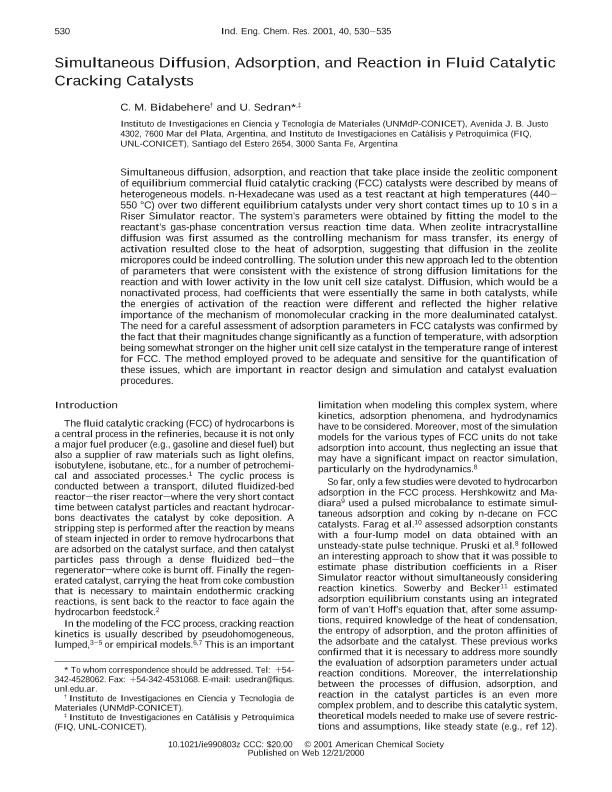Mostrar el registro sencillo del ítem
dc.contributor.author
Bidabehere, Claudia María

dc.contributor.author
Sedran, Ulises Anselmo

dc.date.available
2019-06-19T17:41:25Z
dc.date.issued
2001-04
dc.identifier.citation
Bidabehere, Claudia María; Sedran, Ulises Anselmo; Simultaneous diffusion, adsorption, and reaction in fluid catalytic cracking catalysts; American Chemical Society; Industrial & Engineering Chemical Research; 40; 2; 4-2001; 530-535
dc.identifier.issn
0888-5885
dc.identifier.uri
http://hdl.handle.net/11336/78549
dc.description.abstract
Simultaneous diffusion, adsorption, and reaction that take place inside the zeolitic component of equilibrium commercial fluid catalytic cracking (FCC) catalysts were described by means of heterogeneous models. n-Hexadecane was used as a test reactant at high temperatures (440-550°C) over two different equilibrium catalysts under very short contact times up to 10 s in a Riser Simulator reactor. The system's parameters were obtained by fitting the model to the reactant's gas-phase concentration versus reaction time data. When zeolite intracrystalline diffusion was first assumed as the controlling mechanism for mass transfer, its energy of activation resulted close to the heat of adsorption, suggesting that diffusion in the zeolite micropores could be indeed controlling. The solution under this new approach led to the obtention of parameters that were consistent with the existence of strong diffusion limitations for the reaction and with lower activity in the low unit cell size catalyst. Diffusion, which would be a nonactivated process, had coefficients that were essentially the same in both catalysts, while the energies of activation of the reaction were different and reflected the higher relative importance of the mechanism of monomolecular cracking in the more dealuminated catalyst. The need for a careful assessment of adsorption parameters in FCC catalysts was confirmed by the fact that their magnitudes change significantly as a function of temperature, with adsorption being somewhat stronger on the higher unit cell size catalyst in the temperature range of interest for FCC. The method employed proved to be adequate and sensitive for the quantification of these issues, which are important in reactor design and simulation and catalyst evaluation procedures.
dc.format
application/pdf
dc.language.iso
eng
dc.publisher
American Chemical Society

dc.rights
info:eu-repo/semantics/openAccess
dc.rights.uri
https://creativecommons.org/licenses/by-nc-sa/2.5/ar/
dc.subject
Diffusion
dc.subject
Adsorption
dc.subject
Fcc
dc.subject
Hydrocarbons
dc.subject.classification
Otras Ingeniería Química

dc.subject.classification
Ingeniería Química

dc.subject.classification
INGENIERÍAS Y TECNOLOGÍAS

dc.title
Simultaneous diffusion, adsorption, and reaction in fluid catalytic cracking catalysts
dc.type
info:eu-repo/semantics/article
dc.type
info:ar-repo/semantics/artículo
dc.type
info:eu-repo/semantics/publishedVersion
dc.date.updated
2019-06-19T12:18:04Z
dc.journal.volume
40
dc.journal.number
2
dc.journal.pagination
530-535
dc.journal.pais
Estados Unidos

dc.journal.ciudad
Washington
dc.description.fil
Fil: Bidabehere, Claudia María. Consejo Nacional de Investigaciones Científicas y Técnicas. Centro Científico Tecnológico Conicet - Mar del Plata. Instituto de Investigaciones en Ciencia y Tecnología de Materiales. Universidad Nacional de Mar del Plata. Facultad de Ingeniería. Instituto de Investigaciones en Ciencia y Tecnología de Materiales; Argentina
dc.description.fil
Fil: Sedran, Ulises Anselmo. Consejo Nacional de Investigaciones Científicas y Técnicas. Centro Científico Tecnológico Conicet - Santa Fe. Instituto de Investigaciones en Catálisis y Petroquímica "Ing. José Miguel Parera". Universidad Nacional del Litoral. Instituto de Investigaciones en Catálisis y Petroquímica "Ing. José Miguel Parera"; Argentina
dc.journal.title
Industrial & Engineering Chemical Research

dc.relation.alternativeid
info:eu-repo/semantics/altIdentifier/doi/http://dx.doi.org/10.1021/ie990803z
Archivos asociados
